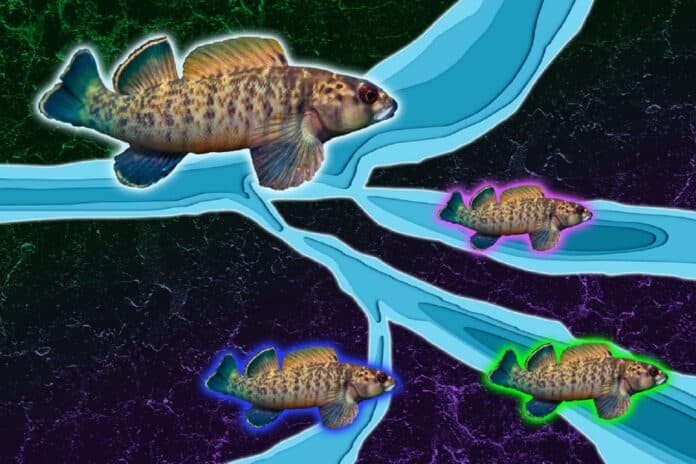The most important information in this study is that biodiversity exists primarily in areas of tectonic turmoil, such as the Himalayan and Andean ranges, which are particularly rich in flora and fauna because of their fluctuating landscapes. However, biodiversity can thrive in geologically calmer locations where tectonics hasn’t disturbed the earth for millennia’s.
The Appalachian Mountains are a great example: the range has witnessed little tectonic activity for hundreds of millions of years, yet it is a significant hotspot of freshwater species.
An MIT study discovered a geological process that may impact species diversity in tectonically inactive areas.
The researchers reveal in an article published today in Science that river erosion can drive biodiversity in these older, quieter ecosystems.
They discovered that as rivers eroded through different rock types in the southern Appalachians, a species of fish known as the greenfin darter was driven into different tributaries of the river network.
These divided populations evolved into their different lineages over time. The researchers believe that erosion caused the greenfin darter to diversify.
Although the separated populations appear identical on the surface, with the greenfin darter’s distinctive green-tinged fins, their genetic makeup differs significantly. For now, the split populations are classed as a single species.
Maya Stokes, Ph.D. ’21, who carried out part of the work as a graduate student in MIT’s Department of Earth, Atmospheric, and Planetary Sciences (EAPS), said, “Give this erosion process more time, and I think these separate lineages will become different species.”
The researchers believe that erosion has caused many additional species to diversify throughout the basin and in other tectonically inactive locations around the planet.
“If we can understand the geologic factors that contribute to biodiversity, we can do a better job of conserving it.” said Taylor Perron, the Cecil and Ida Green Professor of Earth, Atmospheric, and Planetary Sciences at MIT.
New studies developed from Stokes’ doctoral work at MIT, where she and Perron investigated links between geomorphology and biology. Geomorphology is the study of how landscapes change through time. They stumbled upon Thomas Near’s research at Yale, where he looked at the lineages of freshwater fish in North America.
In order to demonstrate how and when specific species evolved and diverged from one another, Near analyses DNA sequence data acquired from freshwater fishes in various parts of North America.
The study discovered that the greenfin darter was only found in the southern part of the Tennessee River Basin and that the genetic makeup of the populations varied based on the tributary in which they were found.
Stokes collected greenfin darter tissue samples from Near’s sizable Yale collection and from the field with assistance from TVA colleagues to look into the causes of this pattern. Then she compared each fish’s genes to every other fish in the dataset after analyzing DNA sequences from across the whole genome.
The team then built a greenfin darter phylogenetic tree based on genetic similarities between species.
Based on this tree, they discovered that fish inside a tributary were more closely linked to one another than fish in other rivers. Furthermore, fish from close streams were more similar to one another than fish from farther away branches.
Perron said, “Could there have been a geological mechanism that, over time, took this single species and splintered it into different, genetically distinct groups?”
Stokes and Perron then used genetic similarities to form a phylogenetic tree of the greenfin darter using DNA sequences from across the complete genome.
They discovered that fish inside a tributary were more connected than fish from other branches and that fish within neighboring branches were more similar than fish from farther away rivers. They also discovered that rivers running through metamorphic rock are steeper and narrower, resulting in more turbulence, which greenfin darters appear to like.
The team wondered if the distribution of greenfin darter habitat could have been shaped by a changing landscape of rock type as rivers eroded into the land over time. To check this idea, the researchers developed a model to simulate how a landscape evolves as rivers erode through various rock types.
They noted where and when connections between streams crossed into non-metamorphic rock, preventing fish from moving between those tributaries. They created a history of these stumbling blocks and compared it to the evolutionary tree of diverging greenfin darters.
The fish appeared to create separate lineages in the same sequence as when their respective tributaries separated from the others.
“It means it’s plausible that erosion through different rock layers caused isolation between different populations of the greenfin darter and caused lineages to diversify.” Stokes said.
Josh Roering, professor of Earth sciences at the University of Oregon, who was not involved in the study, said, “This study is highly compelling because it reveals a much more subtle but powerful mechanism for speciation in passive margins, Stokes and Perron have revealed some of the intimate connections between aquatic species and geology that may be much more common than we realize.”
This study was funded by the mTerra Catalyst Fund and the U.S. National Science Foundation through the AGeS Geochronology Program.
Journal Reference:
- Maya F.Stroke, Sean F.Gallen, etal. Erosion of heterogeneous rock drives diversification of Appalachian fishes. Science. DOI: 10.1126/science.add9791
